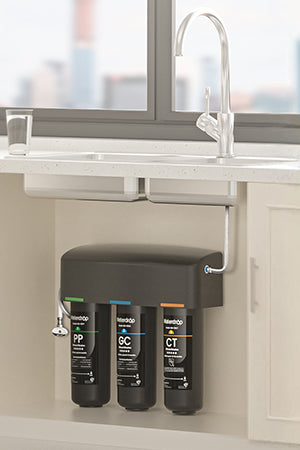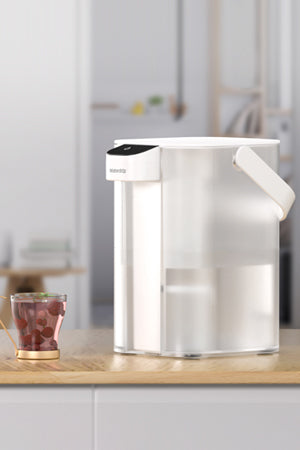Safe and clean drinking water is one of the most basic needs in our daily lives. Many households rely on water filters—whether
pitcher filters , under-sink units, refrigerator attachments or whole-house filtration systems—to remove contaminants and improve taste. But have you ever wondered: Can bacteria grow in water filters? The short answer is yes.
It's a question many people ask because water filters are designed to make water safer. But a filter can also become a breeding ground for microorganisms if not maintained properly. This blog will go into detail on how bacteria interact with water filters, what risks they pose, how to prevent bacterial growth and what you can do to ensure your filtered water is really clean and healthy.
What Are Water Filters and How Do They Work?
Before we get into bacterial growth, let's first understand how water filters work.
A water filter is designed to remove impurities from tap water by using a physical barrier, chemical processes or biological processes. Common filtration materials include:
Use activated charcoal to trap impurities and improve water taste.
Contain tiny pores that block bacteria and sediment.
Use a semi-permeable membrane to remove dissolved salts, heavy metals and microorganisms.
Use ultraviolet light to kill bacteria and viruses.
Designed to filter every drop of water entering a home.
While filters are very good at removing contaminants, they are not self-cleaning. This means they can accumulate bacteria, mold and other organisms if neglected.
Can Bacteria Actually Grow in Water Filters?
The short answer is yes. Bacteria can and often do grow in
water filters . In fact, studies have shown that water filters especially carbon-based ones can become hot spots for microbial growth.
As filters capture impurities like organic matter, those trapped particles can be a food source for bacteria.
Bacteria thrive in dark, damp conditions and the inside of a filter provides exactly that.
Over time,
bacteria form biofilms (slimy layers of microbes) on filter surfaces making them harder to remove.
- Reduced Chlorine Protection
Tap water often contains chlorine which helps suppress bacterial growth. But carbon filters remove chlorine making water inside the filter more welcoming to microbes. So, bacteria are opportunistic. Once the filter provides food, moisture and protection, they can multiply fast.
What Types of Bacteria Grow in Water Filters?
Not all bacteria are bad, but some can be harmful to your health. Some common microorganisms found in neglected filters include:
Pseudomonas
A bacteria found in water that can cause infections in immunocompromised people.
Legionella
Causes
Legionnaires' disease , a type of pneumonia.
E. coli
Usually associated with fecal contamination; some strains can cause severe illness.
Coliform bacteria
Indicators of water contamination, suggesting that pathogens may also be present.
Even if the bacteria themselves aren't highly dangerous, filtered water that passes through a contaminated filter isn't as clean as it should be, which defeats the purpose of having a water filter in the first place.
Is Drinking Bacteria-Contaminated Filtered Water Dangerous?
For most healthy adults, exposure to small amounts of bacteria isn't always harmful. We're naturally exposed to microbes every day. However, drinking water contaminated with high levels of bacteria can pose risks such as:
Stomach issues
Diarrhea, nausea, cramping and gastrointestinal discomfort.
Infections
Certain bacteria can cause urinary tract or ear infections.
Severe illness
In vulnerable groups such as infants, elderly individuals or those with weakened immune systems, bacteria such as E. coli or Legionella can cause serious or even life-threatening conditions.
How Do You Prevent Bacterial Growth in Water Filters?
Fortunately, there are ways to keep your filter water safe and bacteria-free.
1. Replace Filters Regularly
Every manufacturer provides guidelines on how often a filter should be replaced—commonly every 2-6 months depending on usage and filter type. Neglecting replacement is the number one reason bacteria multiply in filters.
2. Flush the Filter After Installation
New filters should be flushed with cold water for a few minutes to remove any debris and activate filtering materials properly.
3. Don't Leave Filters Unused for Long Periods
If you're away from home for weeks, water stagnates in the filter allowing bacteria to multiply. If that happens, replace the filter when you get back.
4. Clean Filter Housings
While the cartridge itself should be discarded and replaced, the filter housing or container can be cleaned with mild soap and water or a diluted vinegar solution to kill any remaining bacteria.
5. Use UV or Reverse Osmosis Systems
Advanced filtration systems such as UV filters are designed to kill bacteria, preventing microbial growth.
How Often Should You Change Water Filters?
It depends on the filter type, water quality and your usage. The following period is for your reference. It is highly suggested to change your water filter regularly according to the manufacturer’s guideline.
- Pitcher filters: Every 2–3 months
- Faucet-mounted filters: Every 3 months
- Refrigerator filters: Every 6 months
- Under-sink carbon filters: Every 6–12 months
- Reverse osmosis membranes: Every 2–3 years (with pre- and post-filters replaced more frequently)
Myth vs. Fact: Bacteria in Water Filters
- Myth: Once bacteria are trapped, they die.
- Fact: Filters trap bacteria but many survive and even multiply.
- Myth: Filters kill bacteria.
- Fact: Most filters (like activated carbon or ceramic filters) don't kill bacteria—they only trap them. Special systems like UV filters are required to disinfect water.
- Myth: Clear, good-tasting water is safe.
- Fact: Water can taste and look fine but still be contaminated with bacteria invisible to the naked eye.
Signs That Your Water Filter May Have Bacterial Growth
It's not always obvious when bacteria are growing in your filter but some warning signs include:
- A strange or musty odor coming from the water.
- Slimy residue in filter housings.
- Cloudy water, even right after filtration.
- Reduced water flow rate which may indicate clogging and biofilm buildup.
If you notice any of these, replace the filter immediately.
Takeaway
So, can bacteria grow in water filters? Yes, they can—and they do if you don't replace or maintain your filters. A neglected filter can actually make your water worse not better.
To keep your family safe:
- Replace filters as directed.
- Clean properly.
- Consider upgrading to UV or RO filters for extra protection.
Remember, a water filter is supposed to protect you from contaminants—but only if you take care of it.




































































